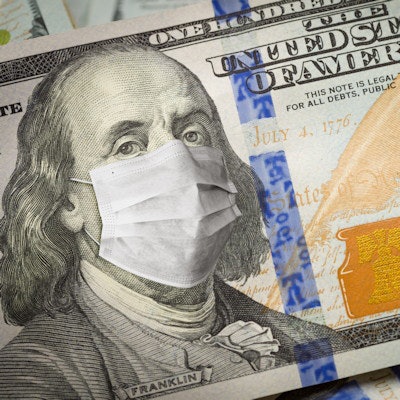
Most radiology practices received an initial distribution from the Provider Relief Fund (PRF) from the U.S. Department of Health and Human Services (HHS) in April 2020. This was the automatic payment (by direct deposit in most cases) that came without much notice following passage of the Coronavirus Aid, Relief, and Economic Security (CARES) Act.
Any practice that received more than $10,000 at that time, and chose to retain the funds, is now required to register and report to HHS on the use of those funds.
Registration on the HRSA portal
The Health Resources and Services Administration (HRSA) of HHS has created an online portal that practices will use for their reporting. Registration for the portal has been available since January and should have been completed already.
If your practice has not yet registered on the portal, this is the first step that should be taken immediately. The HRSA website has user guides that cover the registration as well as the reporting process in detail.
Get ready for reporting
Once registration is complete, the reporting phase can begin. For funds received between April 10, 2020, and June 30, 2020, which includes the initial automatic distribution, the reporting must be completed by September 30, 2021.
 Rebecca Farrington.
Rebecca Farrington.This is an important deadline; if it is not met, the practice will have to return all of the funds received from HHS during the April-June 2020 period. We recommend that practices begin now gathering the data that will be required to complete the process in time. A lot of detail will be needed.
The portal account for your practice will be prepopulated with the dates and amounts of the distributions you received. If for any reason the online information does not agree with your records, you will not be able to proceed and you will have to contact the HRSA provider support line by phone to resolve the situation. As this could take some time, it would be wise to ascertain as soon as possible whether the data are correct.
After logging in to the Reporting Portal and answering some demographic questions about the practice, the funding information described above is presented (this is on the third screen of the portal). If it is correct, then log out and begin collecting the rest of the data that will be needed.
The portal will allow you to save information already entered and return later to complete the remainder. However, you may not skip any required fields without making an entry, even if it is a zero.
Detailed data will be needed
The purpose of the Reporting Portal is for HHS to determine if the practice used the grant funds appropriately. The funds could be used to cover expenses incurred by the practice due to the coronavirus, to replace revenue lost due to the coronavirus, or a combination of the two.
For this initial reporting deadline, practices will need detailed data on patient care revenue by payer type as well as practice expenses from January 1, 2019, through June 30, 2021, for each quarter. However, if the practice chooses to report only on lost revenue, then the expense information will not be needed.
The calculation of lost patient care revenue compares revenue for the quarters in 2020 and 2021 either with revenue from the same quarters in 2019 or with 2020 budgeted revenue. If a new service line was added in 2020 or 2021 that was not part of the revenue stream in 2019, then that new revenue can be excluded.
The comparison for each quarter stands on its own to determine the amount of lost revenue. If a quarter in 2020 actually had higher revenue than the same quarter in 2019, that excess is ignored when looking at the lost revenue in future quarters. The following example illustrates the calculation.
| Example of lost revenue due to COVID-19 pandemic for sample practice | ||||
| Quarter 1 (January-March) | Quarter 2 (April-June) | Quarter 3 (July-September) | Quarter 4 (October-December) | |
| 2019 revenue | $90,000 | $90,000 | $90,000 | $90,000 |
| 2020 revenue | $100,000 | $50,000 | $75,000 | $90,000 |
| Lost revenue | $ 0 | $40,000 | $15,000 | $0 |
This example practice had total revenue in 2019 of $360,000 and total revenue in 2020 of $315,000, a difference of $45,000. However, its lost revenue for the purposes of PRF reporting is $55,000 since the $10,000 excess in the first quarter is disregarded.
If the amount received from HHS during this reporting period was $55,000 or less, then the practice has demonstrated that it has used all of the PRF funds. Note that these periods are calendar quarters, not those related to the practice's fiscal year end if it is other than December.
Alternatively, a third method of revenue calculation is available that allows the practice to employ "any reasonable method of estimating revenues." We are hearing that the use of this alternative method will almost certainly increase the likelihood of an audit of the practice's report. The PRF Reporting Portal user guide and other HRSA documents contain detailed instructions on all three reporting methods.
Other sources of funds
Regardless of whether expenses or lost revenue (or both) will be used to report the use of the PRF grant, some sources of funds other than patient revenue must also be reported. Examples include interest earned on the PRF funds, as well as the amount of other assistance received from sources such as the Small Business Administration (Paycheck Protection Program [PPP] or Economic Injury Disaster Loan [EIDL]), Federal Emergency Management Agency (FEMA), state or local government, or business insurance proceeds.
These sources of other assistance are not considered to be patient care revenue for the purpose of computing lost revenue. Revenue received from non-patient care sources such as insurance, retail, or real estate revenues; grants or tuition; contractual adjustments from all third-party payers; charity care adjustments; bad debt; and any gains and/or losses on investments do not need to be reported.
Reporting expenses
In our experience, lost patient care revenue is the simplest method of reporting on the use of the funds, but if your practice did not suffer revenue losses at least equal to the amount of the PRF grants, then you will have to enter the quarterly amounts of (1) general and administrative expenses and (2) healthcare-related expenses.
Practices that received less than $500,000 in PRF grants during this reporting period can list quarterly totals for each of the two categories, while those that received $500,000 or more will have to list their expenses in greater detail.
Keep in mind that the same expenses may not be used to support multiple sources of government funding. Expenses claimed for PPP loan forgiveness, for example, may not be entered as a use of the PRF grant. That separation of expenses must be done by the practice before entering data into the PRF portal.
Again, the Reporting Portal user guide and other HRSA documents contain detailed instructions.
Supplemental data
Following the entry of the financial data described above, the portal will require detailed information for each quarter on personnel and patient metrics from January 1, 2019, to June 30, 2021. The personnel metrics data tables will require practices to calculate a total number of people employed by labor category. Labor categories include clinical, nonclinical, full-time, part-time, contractor, furloughed, separated, and hired.
Patient metrics include inpatient admissions, outpatient visits (in-person and virtual), and emergency visits. Of these, outpatient visits is the category most likely to be reported by a radiology practice, defined in the PRF user guide as the "number of in-person or virtual patient encounters with a clinician in an office-based, clinic, or hospital outpatient department setting that do not require an inpatient admission."
A radiology practice could make the case that image interpretation is not a "patient encounter" and enter zeros in the patient metrics section, or it could enter the procedure volume for all of its charges. The information gathered in this section is for statistical purposes and will not affect the PRF payment status.
Finally, a series of survey questions must be answered. These are to evaluate the impact of the PRF payments on the practice's financial and clinical care situation.
Conclusion
After submitting the report, the practice should be sure to maintain all records supporting the data that were entered for a period of three years from the date the report is filed, according to federal regulations.
This article is not meant to be a thorough discussion of all the intricacies involved in reporting the use of the PRF funds. Rather, it attempts to provide an overview of the circumstances that many radiology practices will encounter as they use the PRF Reporting Portal. Practices should thoroughly read the documentation provided by HRSA and consult with their own advisers before finalizing the submission.
Rebecca Farrington serves as the chief revenue officer for Healthcare Administrative Partners. She has more than 20 years of experience in healthcare sales and management roles, focusing on hospital-based and physician revenue cycle management.
The comments and observations expressed are those of the author and do not necessarily reflect the opinions of AuntMinnie.com.



















